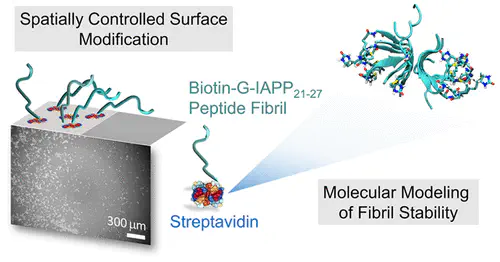Growth, Polymorphism, and Spatially Controlled Surface Immobilization of Biotinylated Variants of IAPP 21–27 Fibrils
 Graphical Abstract: ACS
Graphical Abstract: ACSAbstract
The islet amyloid polypeptide (IAPP) is a regulatory peptide that can aggregate into fibrillar structures associated with type 2 diabetes. In this study, the IAPP21–27 segment was modified with a biotin linker at the N-terminus (Btn-GNNFGAIL) to immobilize peptide fibrils on streptavidin-coated surfaces. Key residues for fibril formation of the N-terminal biotinylated IAPP21–27 segment were identified by using an alanine scanning approach combined with molecular dynamics simulations, thioflavin T fluorescence measurements, and scanning electron microscopy. Significant contributions of phenylalanine (F23), leucine (L27), and isoleucine (I26) for the fibrillation of the short peptide segment were identified. The fibril morphologies of the peptide variants differed depending on their primary sequence, ranging from flexible and semiflexible to stiff and crystal-like structures. These insights could advance the design of new functional hybrid bionanomaterials and fibril-engineered surface coatings using short peptide segments. To validate this concept, the biotinylated fibrils were immobilized on streptavidin-coated surfaces under spatial control.